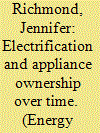| Srl | Item |
| 1 |
ID:
168656


|
|
|
|
|
| Summary/Abstract |
Rural electrification has the potential to transform rural lives and livelihoods by allowing households to use a variety of electric appliances. However, empirical evidence on how rural electrification translates into appliance ownership and usage remains understudied across contexts. Here we use data from the 2014–2015 ACCESS survey in six energy-poor states of India to understand the dynamics of appliance stock accumulation as a function of time since electrification. We find that, controlling for a number of variables, each additional year of electricity access leads to: 1) incrementally higher ownership rates of more power-intensive appliances, 2) increased likelihood of a higher total stock of appliances, and 3) increased probability of owning key appliances, especially TVs, fans, and pressure cookers. These results may help to explain why short-term impact evaluations sometimes find weak evidence for benefits of rural electrification; they also underscore the importance of realistic forecasts of energy demand growth over time after rural electrification.
|
|
|
|
|
|
|
|
|
|
|
|
|
|
|
|
| 2 |
ID:
166727


|
|
|
|
|
| Summary/Abstract |
Increasing block pricing schemes represent difficulties for applied researchers who try to recover demand parameters, in particular, price and income elasticities. The Mexican residential electricity tariff structure is amongst the most intricate around the globe. In this paper, we estimate the residential electricity demand and use the corresponding structural parameter estimates to simulate an energy efficiency improvement scenario, as suggested by the Energy Transition Law of December 2015. The simulated program consists of a massive replacement of electric appliances (air conditioners, fans, refrigerators, washing machines, and lights) for more energy-efficient units. The main empirical findings are the following: in the main counterfactual scenario, the overall residential electricity consumption decreases 9.9% and the associated expenditure falls 11.3%. Additionally, the electricity subsidy decreases 7.5 billion of Mexican Pesos per year (i.e., 403 million of USD at the average exchange rate registered in 2017) and there is an annual cut in CO2 emissions of 3.9 million of tons.
|
|
|
|
|
|
|
|
|
|
|
|
|
|
|
|